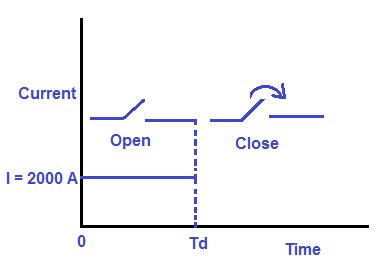The major difference between Instantaneous and Definite Time Overcurrent Relay lies in their operating time. The former operates instantaneously while the latter one operates after a definite time.
Both Instantaneous and Definite Time Overcurrent Relay senses an over current in the circuit and gives tripping command to operate the circuit breaker for isolation of faulty network. Thus their operating principle is same.
Instantaneous overcurrent relay takes no time in giving tripping command once overcurrent is sensed. This means the operating time delay is zero and hence relay operation is instantaneous.
In Definite Time Overcurrent Relay, there is a fixed intentional user settable operating time delay Td. The relay operates if the actuating quantity persists at least for the pre-set time delay. Since the relay operates if the actuating quantity (here overcurrent) persists for definite time, hence the prefix Definite Time is added in the name of overcurrent relay.

Let the overcurrent setting of Definite Time Overcurrent Relay is 2000 A and time delay is Td. If 2000 A current flows for time Td, the relay will operate to change its output contact status. This is shown in figure above. Let us make this clearer.
Suppose the set time delay Td is 200 ms. Does this means that the relay will give tripping command after 200 ms after sensing the overcurrent in the circuit? Is this interpretation correct? No, this is not correct interpretation. The actual interpretation is that the overcurrent in the protected circuit must remain for 200 ms for Definite Time Overcurrent Relay to operate. If the overcurrent only exists for say 190 ms, the relay will not operate.
Apart from the above two types of overcurrent relays, there are various other type like Inverse Definite Minimum Time (IDMT), Inverse, Very Inverse and Extremely Inverse Overcurrent Relay. Their operating principle is quite different from that of Instantaneous and Definite Time Overcurrent Relay. Please read “Over Current Relay and Its Characteristics” to know more about these other types.
Very clear….nice explanation.
Instantaneous relay not operate instantly . There is small time lag
You are correct Rovin. There always exists some time lag due to relay processing. This time lag is around 4 to 5 ms. But ideally it should operate instantaneously as its time setting is zero.